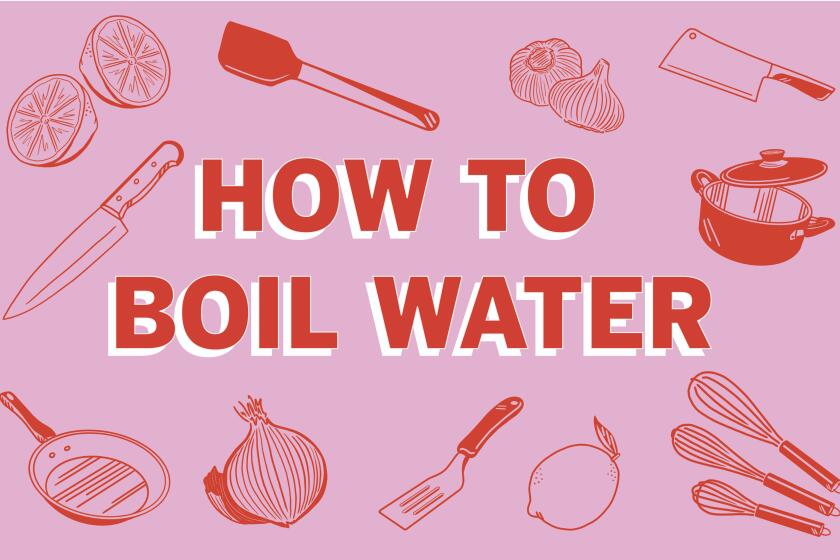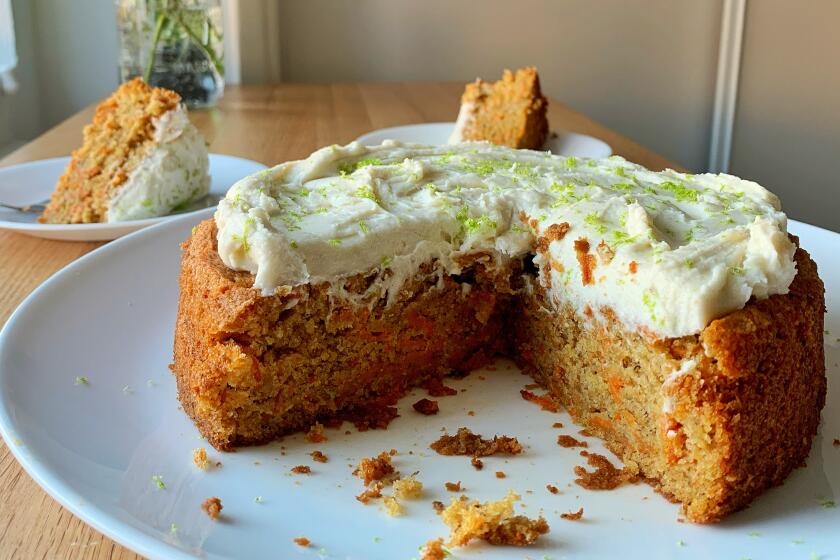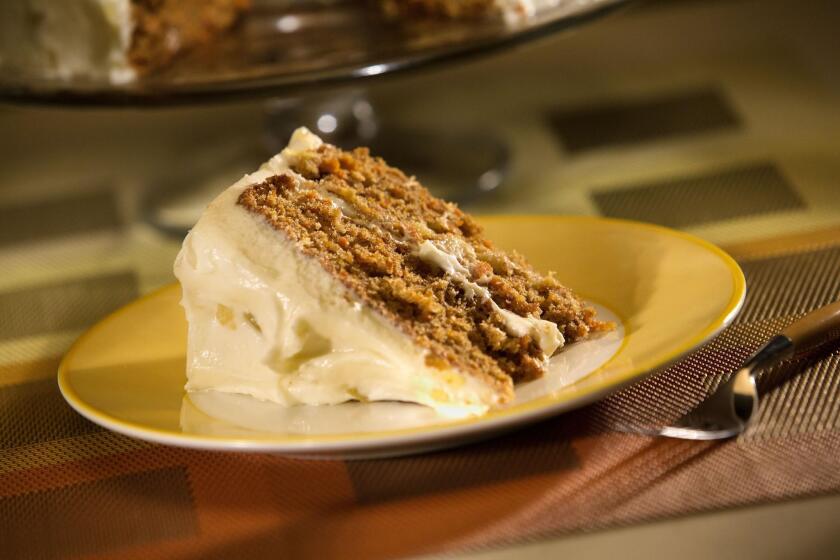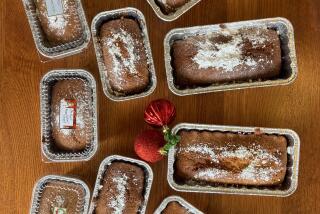A vegan carrot cake that’s better than the original

- Share via
How to Boil Water
With so many of you having to stay home and cook for the first time — ever or more than you have in a long time — we get that it can be overwhelming to have to cook all your meals from scratch. So, we’re here to get you started.
Each day we’re going to post a new skill here and go into detail about how to do it — a resource for cooking basics so you can get food on the table and get through this.
A series of simple tutorials for making some basic recipes at home.
Lesson 21: Carrot Cake
As we’ve settled into the second month of quarantine, my intake of rich butter cookies and biscuits has started to wane. Not because they’re not delicious but because my clothes are starting to feel a little tight.
That’s why I’m making more carrot cake, which has, since the ’80s, been the epitome of “I’m eating a healthy dessert!” Grated carrots in the batter make it seem like you’re eating something actually good for you.
While I love carrot cake in any form, I’ve enjoyed testing the traditional recipe’s limits, seeing how “healthy” I can make it while still keeping it as delicious as the (actually oil-filled very unhealthy) original. And with so many carrots leftover in my produce box that I can’t seem to finish, right now has been a particularly opportune time to experiment with carrot cake formulations.
I leaned into the crunchy-hippie aspects of the vegetable-strewn batter — often packed with dried fruits and nuts — and made my version fully vegan since, aside from the eggs and buttermilk that I like to use, the classic recipe already is.
Carrot cake is the epitome of “I’m eating a healthy dessert!”
Oat milk mixed with some acid is a simple substitute for buttermilk — the acidity of buttermilk reacts with the baking soda in the batter to help it rise and brown well on the outside — but any acid will do the trick. I find lemon or lime juice work best.
As for the eggs, there are dozens of substitutes, but the one I know to work the best from my own experience making these types of cakes is good ol’ mashed bananas, which contribute subtly to the flavor of the cake. It’s another ingredient many of us have lying around even in quarantine times.
This cake is also the perfect place for that whole wheat flour you panic-bought. The earthiness of the wheat’s bran works well with the carrots, bananas and walnuts in the batter.
I go with a ratio of 2 parts all-purpose flour to 1 part whole wheat flour, but you can get away with using equal parts though the texture of the finished cake will be a tad drier and the crumb more crumbly.
I use an admittedly tedious ¾ cup plus 2 tablespoons of sugar, but it’s that Goldilocks measurement that I found gives this cake the best balance of sweetness. If you want a less sweet cake, go with ¾ cup; for a crowd-pleaser, go with a full cup. Final adjustments for our current times: I omit the sweetened coconut shreds and crushed canned pineapple (Who really keeps that around anyway?) found in traditional recipes and lean into making this a capital-C CARROT cake with carrots only; however, some chopped walnuts, which I love to use, are a welcome addition, as are raisins, if you like ’em and have ’em around.
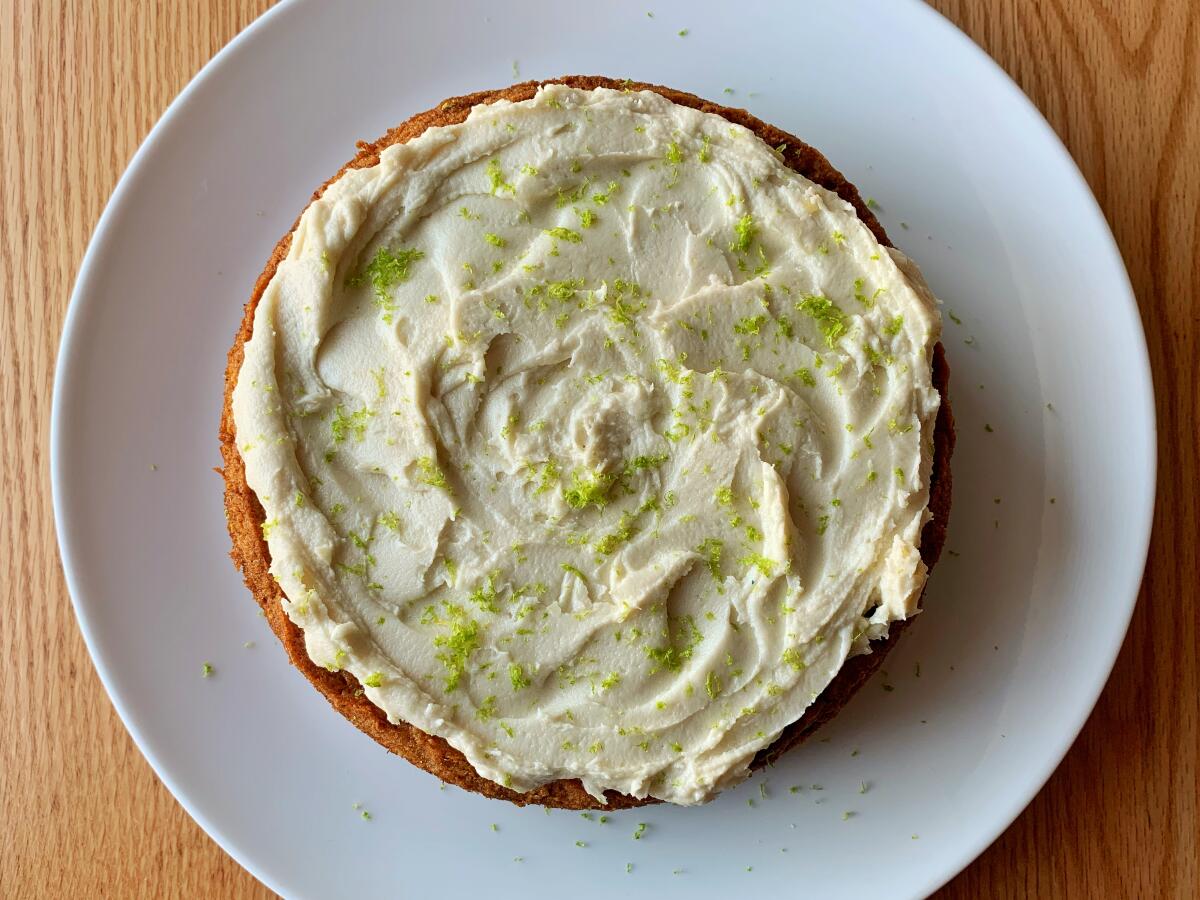
That takes care of the cake; when it comes to making a vegan substitute for the cream cheese frosting, things get a little trickier. You can eat the cake plain or with a simple dusting of powdered sugar. But if you want to go the extra mile — maybe for a special-occasion dessert, or because you’re one of those people that doesn’t consider cake cake without the frosting — make my vegan version of “whipped cream” frosting. In my collection of old Southern recipes, I found this type of frosting — where a cooked milk pudding is whipped with butter — was the traditional coating for red velvet, which is another cream-cheese-cloaked cake. I’m sure it fell out of fashion because beating cream cheese with sugar is easier. But if you’re looking to fill the hours, why not?
Start by whisking together sugar and all-purpose flour in a small saucepan (the sugar breaks up the flour so it doesn’t clump), then pour in milk. For my vegan version, I use oat milk since I use it in the cake batter too, but you could use any other alternative milk. Bring this mixture to a boil and, once it thickens to somewhere between pudding and wallpaper paste, cook it for another minute just to get rid of any raw flour flavor. Stir in vanilla extract and salt, then let the mixture cool to room temperature before chilling it in the fridge to thicken further. All that’s left is to add some fat. I use organic vegetable shortening because it provides the best texture and mouthfeel — plus, you’re only using 1/3 cup — but you can use a vegan butter substitute, such as Earth Balance sticks or firm refined coconut oil if you feel icky about shortening. Beat the hell out of the shortening and pudding with a wooden spoon until they combine into a frosting that’s fluffy and light like stiff whipped cream.
Slather the frosting over the cake, then grate a little lime zest over the top. The zest cuts the richness of the frosting and also brings out the tropical vibes of the bananas. Close your eyes and picture yourself on a beach in the Caribbean, looking amazing because you’ve been eating this super-very-totally-healthy dessert. It’s fantasy but so is the fact that you’ll be on that beach anytime soon.
Vegan Carrot-Banana Cake
Want more carrot cake recipes?
From Duff Goldman’s Charm City Cakes recipe to the version served at the Madonna Inn, here are eight of our favorite carrot cake recipes.
More to Read
Eat your way across L.A.
Get our weekly Tasting Notes newsletter for reviews, news and more.
You may occasionally receive promotional content from the Los Angeles Times.
